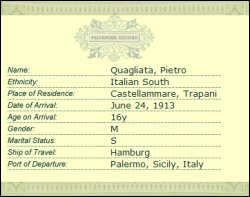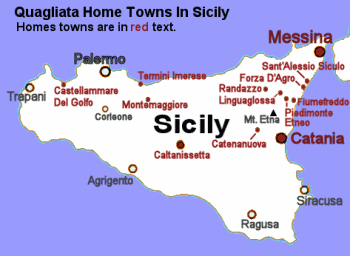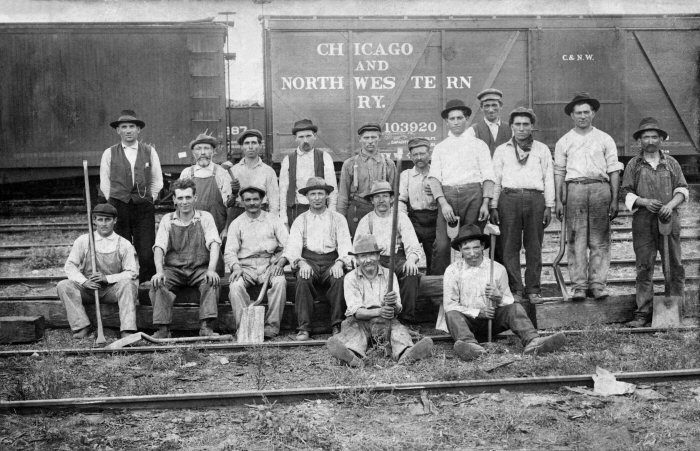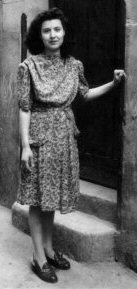KNOWLEDGE
ACQUISITION
How did we arrive at the current state of our knowledge? Originally,
second cousins once removed, Richard Quagliata (b. 1955) and Michael
Quagliata (b. 1953), combined efforts to document their family's lineage.
According to oral history as told by family members, and collected prior to
1980, Mario Quagliata (1843-19??), had 16 sons and a daughter by two wives.
When this website was first published in 2001, we knew of Mario Quagliata
(1843-19??), his second wife and three of their children, as well as Louis Quagliata's (b. 1937) family from Rome, and John Quagliata's (b. 1940)
family in Cleveland. Over the next couple of years, information began
to trickle in as our website was added to the data bases of many ancestry
websites and internet search engines like Yahoo! and Google, eventually making us
easier to find. In 2003, the pace of incoming contributions began to
pickup. Visitors were donating genealogical listings, documents, photos, family narratives
and providing us with corrections. A fairly complete list of all those
who have contributed can be found on the
Contributors
page. Richard's Chart, a
complete genealogical listing of our current state of knowledge,
began to grow as more and more visitors added their lineages - currently it
is over 50 pages long. The linkages of some of the listed lineages are
based on documentation, while others are guess work based on names, dates,
hometowns and family relationships. In 2005, John Quagliata (b. 1940),
of the Cleveland, Ohio family, provided us with a detailed and documented
listing of his family. He is one of the few contributors who gained
his knowledge by researching marriage, birth and death records from Sicily.
John was able to take his family's listing all the way back to the late
1700s. He has also spent many hours researching for other lines,
including mine. Thanks to John's work in 2006, we now know Mario
Quagliata was born about 1843, Mario's parents names, the names of eight of
the children from his marriage to Maria Barcellona, as well many other names
and dates. Then in May of 2007, our long time contributor Vittorio
Quagliata of Milan emailed us our most exciting news to date. Vittorio
discovered a booklet researched and written by Professor Iana Quagliata of Monza about
the life of Giambattista Quagliata (1603-1673, aka Giovan Battista Quagliata). Iana's booklet
contained a wealth of information about Giambattista, pushing our family
tree back to the 1500s. In 2023, Ramiro Quagliata, of one of the
Quagliata families in Argentina, contributed the reseach he has conducted
over the last year. Ramiro's sources include Antenati Italiani and
Family Search. He has made contributions to many lineages, including
his own. As our contributors provide more information,
our knowledge continues to grow. The information presented here and in
the family narratives is only as accurate as our current knowledge and information,
and we welcome any help our visitors might provide. From time to time,
changes in the narratives are made as newer and/or more accurate information
is acquired.
A NARRATIVE
HISTORY
Let us start from an interesting place -
the Quagliata Coat of Arms. Thanks to the work
and research contributed by Professor Iana Quagliata of Monza,
Italy, in 2007, we know that the Heraldic Archives of Vallardi has a record of the Quagliata Coat of Arms.
On page 229 the following entry is found (translated from the
original Italian):
.
| ....... |
Quagliata. The arms of this
noble family has the following Blazon:
The arms: Left: in the primary of gold, a chevron group of
red supporting a castle with two of the same Ghibelline
merlons and accompanied within the point by an identical
second castle; in the second of blue, three bars of silver,
the second one charged with a quail in close pose, also she
is within the bar. |
....... |
.
The rendering on the upper right was done by the
Guelfi Camajani
Studio of Heraldry in Genoa, Italy, using the above description
(larger view
here).
You can learn more about the Quagliata Coat of Arms
here. |
Quagliata Coat of Arms

As described in the
Heraldic Archives of Vallardi. |
| Professor Iana Quagliata
has also confirmed that sometime between 1649 and 1651,
the
Viceroy of Sicily,
Don Juan José, granted the well known Messinese artist and
architect Giovan Battista Quagliata (1603-1673; also known as Giambattista
and Giovanni) a
noble title, with a coat of arms and land south of Messina.
The Quagliata Coat of Arms described in the
Heraldic Archives of Vallardi is actually a
combination of two coats of arms - one residing in the left half of
the shield area, and one in the right half. The one on the
left, in the primary partition, is of gold and red and
would be the older of the two coats. The one on the right, in
the secondary partition, of blue and silver, is the more recent of
the two coats. After a study of the Quagliata Coat of Arms, we
have concluded the coat in the secondary partition to be the one
belonging to Giovan Battista Quagliata, granted to him by his
friend, patron, and student, Viceroy Don Juan José. We have
put the coat we believe belongs to Giovan in a rendering by itself,
which is depicted on the right. We
can see that all the symbology in this coat fits the artist and
architect Giovan Quagliata:
The shield is in blue (truth and loyalty), with 3 silver (peace and
sincerity) bars and contains a quail (reflection and truth).
This conclusion leaves us to discover the owner of the more ancient of the
two coats - the coat in the primary partition of gold and red. |

Giovan Battista Quagliata
Coat of Arms c. 1650 |
| The farthest back we've been able to take our documented
research is the 1500s - to Giovan
Domenico Quagliata (1540?-16??) and his son Giovan Battista Quagliata
(1603-1673). However, we can use our study of the Quagliata
Coat of Arms to extrapolate even further back in time. We now
turn our focus to the coat on the
left side of the Quagliata Coat of Arms described in the Heraldic
Archives of Vallardi. This coat, in the primary partition, has militaristic
symbology:
Ghibelline castles, a
chevron and uses of the color red (warrior or martyr; military
strength and magnanimity). In Italy, from 1155 into the 1300s,
the medieval age was a time of unending conflicts and battles for
Ghibellines, Guelphs, Italians, Frenchmen and Spanish, as most of
southern Europe was involved in these disputes. During this
time period in Italy, there was a conflict between the Ghibellines and Guelphs,
factions supporting, respectively, the Holy Roman Emperor and the
Pope in central and northern Italy. The coat of arms depicted
on the right shows a chevron
(symbolizing protection) grouped with two Ghibelline castles,
indicating that the holder was most likely an important military
leader who protected a castle or multiple castles from attack.
We can infer that at sometime between 1200 and 1400, an
ancestor of Giovan Battista Quagliata was granted a noble title, and the coat of arms shown on
the right, for service to the Ghibelline party. Giovan
would have inherited the earlier coat of arms.
The rules of heraldry allow the holder of multiple arms to put them
together in a display on one shield. We can therefore conclude
that Giovan
combined the inherited coat with
his own, displaying the two arms together on his shield, which was divided in 'perpale'
partitioning (vertically in half), a division style that is
considered to be the format of the Ghibelline party. |

Ancestral Quagliata
Coat of Arms c. 1200-1400 |
So, according to our study of the Quagliata Coat of Arms, we can state
the following with a measure of confidence: During the years 1200-1400, the Quagliata family
was involved with the Ghibelline party in central and northern Italy.
At some point during this time period, a member of the family, who was an
ancestor to Giovan Battista Quagliata (1603-1673), was granted a noble title
and a coat of arms "of gold, a chevron group of
red supporting a castle with two of the same Ghibelline
merlons and accompanied within the point by an identical
second castle."
This brings us to the later half of the 1400s and the earliest documented reference to the Quagliata name our research has
uncovered: that of Elisabetta Quagliata (1480?-15??) of Pordenone, Italy,
located northeast of Venice. Her name comes up in
reference to the
famous painter,
Il Pordenone, who's given name was actually Giovanni Antonio Licino
(1483-1539). Licino had several aliases, including Giovanni Antonio
de' Sacchis and Giovanni Antonio Pordenone (the name of the town of his
birth, Pordenone). We have several sources that document the name of
Pordenone's second wife as Elisabetta Quagliata. The following is a
quote from "A History of Painting in North Italy: Venice, Padua, Vicenza,
Verona, Ferrara, Milan, Friuli, Brescia, from the Fourteenth to the
Sixteenth Century", published 1871: "Pordenone returned to his native place
[Pordenone, Italy] at the opening of 1513 and... took for his second wife
Elizabeth [Elisabetta] Quagliata, a widow of some fortune who showed her
devotion to him by vesting the whole of her property in his person.
From this time forward, commissions overwhelming in number and importance
poured in upon him." It would seem that Elisabetta Quagliata was
wealthy and influential. Unfortunately we have not been able to
determine if Quagliata was her maiden name, or the surname of her first
husband. We have also been unable to link Elisabetta to our family
tree. It should also be noted that one of our references spells her
last name Quagliati - a variant of Quagliata known to be found in northern
Italy.

Now we move on to the 1500s.
During this period, Sicily was part of the Spanish Aragon empire and was
ruled by the King of Spain via governors and viceroys. Thanks to the work and research contributed by Professor Iana Quagliata of
Monza, Italy, in 2007, we can now say with a reasonable amount of certainty
that the Sicilian lineage of the family goes back to the artist Giovan
Domenico Quagliata (1540?-16??). According to our current information,
it appears that Giovan Domenico may be the link between the mainland and
Sicilian Quagliata branches. Much of the following information is
from Professor Iana Quagliata's book "Giambattista Quagliata Painter and
Architect of the 1600s". Professor Quagliata often refers to a
reference work on the painters of Messina from the 1600s written by
Francesco Susinno in 1724.
Giovan Domenico was a painter who lived in
Rome in the late 1500s. He was an artist of talent, but not greatness.
Unfortunately, we currently don't know the details of Giovan Domenico's
birth. I found a
reference to Giovan in the book Sicillia concerning his painting Madonna
of the Itria - the attributed date is after his death and is inaccurate.
The available resources indicate his birth date at approximately 1540. His
birth place remains a mystery. If he was born on the mainland, it's
highly likely he was part of the Quagliata family located in Balvano.
Possibly looking for a better market for his talent and art, Giovan Domenico
moved to the growing trade center of Messina, arriving in Sicily in the late
1500s. Unfortunately Susinno does not cite the works of Giovan Domenico.
Sometime before 1600, Giovan Domenico married a woman from Messina named
Francesca LeDonne and together they had children. We know of two sons:
Andrea
Quagliata born in 1594 (or in 1599, and died in 1660) and
Giovan Battista Quagliata born in
1603 (1603-1673).
And now we are into the 1600s. There is an old woodcut print picture of Giovan
Battista (also known as Giambattista and Giovanni) shown above on the right (click for a
larger
view). The picture was found on the unnumbered page preceding page
159 of
the book "Memorie de' pittori messinesi e degli esteri che in Messina
fiorirono dal secolo XII. sino al secolo XIX", published by G. Pappalardo,
1821 Harvard University (a book about the painters of Messina from the 12th
through the 19th centuries, which includes a section on Giovanni
Quagliata). Continuing with the narrative, Andrea became a student of his father and was a
capable painter. Giovan Battista was directed by his parents to study
letters, but his studies were interrupted by the premature death
of his father, Giovan Domenico. Andrea, by that time a professional painter, convinced his
younger brother to attend his school where Giovan Battista does well.
Andrea married, but apparently did not have children.



.
Paintings of
Giovan Battista
Quagliata
Click for a larger view with details. |
Giovan Battista helped his brother with household income by painting
small pictures and portraits. Giovan became so attracted by the art of painting that he
decided to journey to Rome to attend the prestigious school of
Pietro
Berrenttini from Cortona. As Giovan Battista continued his
studies, it soon became clear that he was more talented than both his
father and his brother, Andrea. About age 24, he married a Roman
woman named Cinzia Conticelli. During those years in Rome he
created many works documented in the registers of the parish of San
Nicola in Arcione, and he became a member of the Academy of Saint Luke -
an association of artists in Rome, founded in 1593 for the purpose of
elevating the work of "artists" above that of craftsman, and it is still
active today.
At age 37, perhaps enticed by lucrative commissions, Giovan Battista
returned to Messina in 1640. There he enjoyed the patronage of the
Viceroy of Sicily, Don Juan José of Austria. The Viceroy became a
student of Giovan's and the two became friends. Then, Giovan's first wife, Cinzia, died and sometime later he married Flavia
Alias, sister of the famous mathematician of the Company of Gesu
Vincenzo Alias. Giovan produced many famous works during this
period. In time, Viceroy Don Juan José
granted Giovan Battista Quagliata a noble title with a coat of arms
(seen on the right, click for a
larger view) and
some land in the countryside area of Forza D'Agro, Sicily, between the
city and the sea, where the new city of Sant’Alessio
Siculo later developed. It is certain that some of Giovan's family
settled there. Giovan's works - paintings, frescos and large
canvasses - were famously displayed in the galleries and
churches of Messina, but due to earth quakes from Mt. Etna and wartime bombings,
few have survived to the present day. Giovan had at least two children - we know of two sons. |

Coat of Arms granted to
Giovan Battista Quagliata
(1603-1673)
by Don Juan José
Viceroy of Sicily
Click for a larger view with details. |
This brings us to the 1700s. According to
historical information presented above, we know Giovan Battista
Quagliata (1603-1673) was married twice: First about 1627, and then, after his
return to Messina and the death of his first wife, married again sometime
after 1640. So now we have a bit of conjecture: Any of Giovan's
children, including those two sons, could've have lived into the 1700s and
most likely lived on the lands owned by their father in the area of Forza
D'Agro. Although we have no records that directly link Giovan's
lineage to ours, we do have a record for my great-great-great
grandfather, Carmelo Quagliata (1781?-18??) living in Forza D'Agro, where
his son, my great-great grandfather, Mario Quagliata (1843-19??) was born.
This information allows us to form a lineage based on the information we
have.
Below is a chart that depicts the more ancient portion of
the Quagliata lineage. Using our current knowledge, we hypothesize
that the mainland and Sicilian branches split in the 1500s. At that
time, a Quagliata family, probably originating from Balvano, had moved to
Rome. A member of that family named Giovan Domenico Quagliata moved to
Messina and his son Giovan Battista Quagliata was granted lands near Forza
D'Agro and Sant'Alessio Siculo. Thanks to the work of John Quagliata
of Cleveland, we have well documented Quagliata lineages that trace back to
those lands in the 1700s - a mere one hundred years after Giovan Battista
Quagliata's death we have
records of family births leading to our currently known lineages. It is now certain that the Quagliata family lines that
trace back to Sant'Alessio and Forza D'Agro are related to Giovan
Battista Quagliata. These lines include the Sant'Alessio
patriarchs Pasquale Quagliata (with branches in Rome, Milan, Mexico City
and New Brunswick, New Jersey), and Carmelo Quagliata (with branches in
Cleveland and Rome); and the Forza D'Agro patriarchs Giuseppe Quagliata
(with a branch in Hartford Connecticut), Carmelo Quagliata (the
father of Mario Quagliata (1843-19??), with
branches in St. Louis, Chicago and Michigan), and Angelo Quagliata (with
branches in Pennsylvania and who was also tied to the Sant'Alessio families). It is also most likely that
the Quagliata family lines that trace back to the north side of Mt. Etna
are also related to Giovan Battista, including the lines from Piedimonte
Etneo (the Lyons/Rochester family and the Tully/Sidney, Australia
family), and Fiumefreddo (the Ayr, Australia family). Furthermore,
it's possible that the rest of the Quagliata families in Sicily are related
to the Sant'Alessio area and Giovan Battista. So it seems the old family stories about all
Quagliatas being related through the little town "south of Messina" are
true. Many thanks to Professor Iana Quagliata, originally from
Forza D'Agro and currently residing in Monza, Italy, who researched
Giovan Battista Quagliata and contributed her work to our project.
Also, thanks go to our long time contributor Vittorio Quagliata of Milan
for his efforts in acquiring this information for our project.
|
 |
All the lineages we know of are
mapped to the town their earliest known ancestor on the map below; listed by
town and patriarch. The Quagliata family that originally formed
the basis of the genealogical listing we are developing is descended from
the two marriages of Mario Quagliata (1843-19??), the son of Carmelo
Quagliata (1781?-18??) from Forza D'Agro (listed in the chart above). Since then, we have
widened the scope of our project to include all Quagliata lineages. It
should be remembered that these listings are just branches of the global
Quagliata family tree.
|
.
Quagliata Origins
Towns of origin are
shown along with patriarchs and
the places to
where their descendants immigrated.
,
 |
The narratives of lineages with unknown linkage to
Mario's line can be found on the More
Quagliata Narratives page. Below is a small lineage chart that shows the known
children of Mario (as our current information shows them to be) and where
they or their descendants immigrated to from Sicily (unknown names and
dates, or possible destinations are indicated by a question mark "?").
The chart is based on information we've gathered, including names, dates,
hometowns, family relationships and written documentation. And now,
we'll continue with the narrative, which presents the story of Mario's children and their
descendants, following the birth order of Mario's children. |
 .. THE
QUAGLIATA FAMILY
.. THE
QUAGLIATA FAMILY




















































